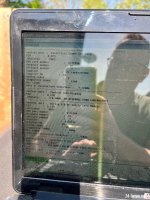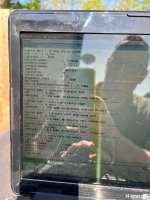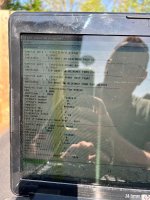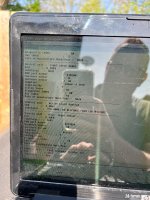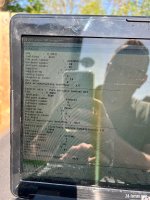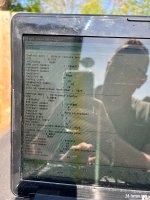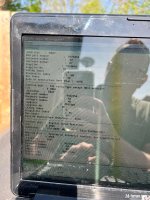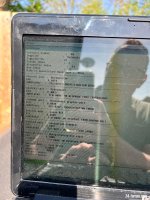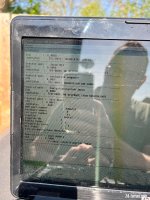You are using an out of date browser. It may not display this or other websites correctly.
You should upgrade or use an alternative browser.
You should upgrade or use an alternative browser.
Jigsaw- electrical issues before I admit defeat ***SOLVED***
- Thread starter bigwinn
- Start date
j3nks79 said:It’s looks like a bad earth.
All earth points checked but I agree it looks like a wire break or two causing earthing issues
enuff_zed said:Give it a week or so and I'll post him back the bit I nicked off it when I went to view it for him.

I’d pay good money for that!!!
Usel
Senior member
Just done a continuity check with a multimeter on a disconnected fuse box on my work bench.
Fuse 38 (wipe wash system) is connected to all these fuses:
5,10,15,16, 19,20,24,26,27,29,36,37,39 40,41,48,49,50, 54, 55, 56, 57, 58, 59, & 60.
This explains why you get so many different problems when the wiper is used.
Basically if the circuit for fuse 60 has a positive ground then it will effect every fuse listed above.
Is the squib OK? Is the wiper stalk OK?
Fuse 38 (wipe wash system) is connected to all these fuses:
5,10,15,16, 19,20,24,26,27,29,36,37,39 40,41,48,49,50, 54, 55, 56, 57, 58, 59, & 60.
This explains why you get so many different problems when the wiper is used.
Basically if the circuit for fuse 60 has a positive ground then it will effect every fuse listed above.
Is the squib OK? Is the wiper stalk OK?
Usel said:Just done a continuity check with a multimeter on a disconnected fuse box on my work bench.
Fuse 38 (wipe wash system) is connected to all these fuses:
5,10,15,16, 19,20,24,26,27,29,36,37,39 40,41,48,49,50, 54, 55, 56, 57, 58, 59, & 60.
This explains why you get so many different problems when the wiper is used.
Basically if the circuit for fuse 60 has a positive ground then it will effect every fuse listed above.
Is the squib OK? Is the wiper stalk OK?
Cheers Rob
What’s the squib? I’ve checked the slip ring/wiper stalk seems ok
Fuse 60 from memory is a big one, yes?
pvr said:Never knew about the shared fuses that impact others, you learn something all the time (unfortunately at your expense Stuart)
Taking one for the team bud
Usel
Senior member
enuff_zed said:So are you saying that an issue on any one of those circuits will potentially affect all the others you listed?
Yes, think of it like a ring main in a house. One ring main will feed power to the sockets in the lounge, dining room and hallway.
You have plugged in a tv (drivers seat heating,) a lamp (wipers,) a router (passenger seat movement) etc etc
If one of those has a short it can play havoc with everything else.
I suspect there's a short on one of the many fuses I listed above that is say putting 2v (guessing) constantly into ground. Anything sensitive like the drivers seat movement will not work. The passenger seat has a more robust seat switch (no memory) so that still works. When the component with the short is used that puts more power through the ground and creates more problems. Which is why when the roof is used the wipers start moving.
The wipers whilst seem the problem may actually be fine. The power may go to that first as it's the path of least resistance.
I am no expert, just trying to think outside the box. I have never done this but I believe you can measure the current draw across the top of a fuse. When the car is at rest and everything powered down you can put a multimeter either side on top of the fuse to see how much power is being used. You may need a multimeter that measures milivolts but you may get success on the 20v setting especially if the short is above 1v.
Rob, you do seats and electrickery and I’ll do the oily bitsUsel said:enuff_zed said:So are you saying that an issue on any one of those circuits will potentially affect all the others you listed?
Yes, think of it like a ring main in a house. One ring main will feed power to the sockets in the lounge, dining room and hallway.
You have plugged in a tv (drivers seat heating,) a lamp (wipers,) a router (passenger seat movement) etc etc
If one of those has a short it can play havoc with everything else.
I suspect there's a short on one of the many fuses I listed above that is say putting 2v (guessing) constantly into ground. Anything sensitive like the drivers seat movement will not work. The passenger seat has a more robust seat switch (no memory) so that still works. When the component with the short is used that puts more power through the ground and creates more problems. Which is why when the roof is used the wipers start moving.
The wipers whilst seem the problem may actually be fine. The power may go to that first as it's the path of least resistance.
I am no expert, just trying to think outside the box. I have never done this but I believe you can measure the current draw across the top of a fuse. When the car is at rest and everything powered down you can put a multimeter either side on top of the fuse to see how much power is being used. You may need a multimeter that measures milivolts or but you may get success on the 20v setting especially if the short is above 1v.
Usel
Senior member
enuff_zed said:Rob, you do seats and electrickery and I’ll do the oily bits
Ha!
What is helping me understand in this situation is a smart meter install going badly wrong in one of my clients properties.
Smart meter install was at 9am, 2 different electrician companies and 5 electricians later, I finally managed to leave the property at 8pm with a partial fix feeding power to the essentials.
I was only supposed to be there an hour

Usel said:enuff_zed said:So are you saying that an issue on any one of those circuits will potentially affect all the others you listed?
Yes, think of it like a ring main in a house. One ring main will feed power to the sockets in the lounge, dining room and hallway.
You have plugged in a tv (drivers seat heating,) a lamp (wipers,) a router (passenger seat movement) etc etc
If one of those has a short it can play havoc with everything else.
I suspect there's a short on one of the many fuses I listed above that is say putting 2v (guessing) constantly into ground. Anything sensitive like the drivers seat movement will not work. The passenger seat has a more robust seat switch (no memory) so that still works. When the component with the short is used that puts more power through the ground and creates more problems. Which is why when the roof is used the wipers start moving.
The wipers whilst seem the problem may actually be fine. The power may go to that first as it's the path of least resistance.
I am no expert, just trying to think outside the box. I have never done this but I believe you can measure the current draw across the top of a fuse. When the car is at rest and everything powered down you can put a multimeter either side on top of the fuse to see how much power is being used. You may need a multimeter that measures milivolts but you may get success on the 20v setting especially if the short is above 1v.
Rob
All makes eminent sense and explained in simple terms! Thank you
I can follow the thinking, but that would mean that it triggers a relay to provide the main circuit to the wipers and you would hear the audible relay click from that.
To continue thinking that way - Stuart, do you hear an unrelated relay switch at the time of roof opening?
To continue thinking that way - Stuart, do you hear an unrelated relay switch at the time of roof opening?
Similar threads
- Replies
- 2
- Views
- 2K
- Replies
- 6
- Views
- 244
- Replies
- 4
- Views
- 435
